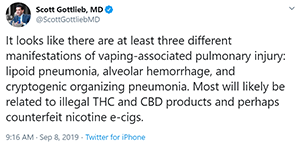Cannabis Legalization Anchors U.S. Sen. Kamala Harris’ Criminal Justice Plans
Marijuana Industry News September 9, 2019 MJ Shareholders
Editor’s note: This is a developing story. Cannabis Business Times and Cannabis Dispensary are gathering information from across the industry for an upcoming special report on how to respond to new information and ongoing public health research.
The perplexing narrative of vaping-related lung illnesses escalated into a full-blown national media frenzy last week with news that a fifth person had died from alarming pulmonary symptoms. While not every case of this mysterious disease is linked to concentrated cannabinoid cartridges (or even products sold in legal state cannabis markets), the question of what, precisely, is causing vaping technology to harm individuals has captured the American consumer’s attention.
On Sept. 5, the New York State Department of Health issued a warning against illicit-market vape products, including the rash of branded cartridges that have appeared across the U.S. in recent years. (This includes “Chronic Carts” and “Dank Vapes,” according to photos provided by the department.) The state’s health officials pointed specifically to vitamin E acetate as a potential culprit. “Vitamin E acetate is a commonly available nutritional supplement that is not known to cause harm when ingested as a vitamin supplement or applied to the skin,” according to the department’s press release. “However, the Department continues to investigate its health effects when inhaled because its oil-like properties could be associated with the observed symptoms.”

New York State Department of Health
Even as the department was publishing its health advisory, a third death, this time in Indiana, was linked to vaping products; by the weekend, the death count had risen to five. The Centers for Disease Control and Prevention (CDC) reports more than 450 other cases of vaping-related illnesses in 33 states.
“The cases of pulmonary illnesses associated with vaping are continuing to rise across New York State and the country,” New York Health Commissioner Dr. Howard Zucker said in a public statement. “We urge the public to be vigilant about any vaping products that they or any family members may be using and to immediately contact their health care provider if they develop any unusual symptoms. In general, vaping of unknown substances is dangerous, and we continue to explore all options to combat this public health issue.”
But the state’s view on vitamin E acetate is only one hypothesis in an industry-wide conversation. The CDC has pointed specific diagnoses in some vapid-related cases for “lipoid pneumonia,” a form of the disease caused by “aerosolized oils” deposited in the lungs and triggering “a local inflammatory response that impaired vital gas exchange.”
“Though it has not been studied well, I suspect if you were to do a bronchoscopy on someone who vapes regularly, we may detect low levels of lipid particles in their lungs, even when they haven’t had enough to cause an injury,” University of Utah pulmonologist Dr. Andrew Freeman said in a July 2019 article about vaping-related lipoid pneumonia. “Thus, lipid droplets may not be causing irritation or injury to the lungs in all cases, but they are probably there. And the higher burden of lipid, the overall greater chance of developing lipoid pneumonia.”
While health officials are targeting all vape products and technologies (including “e-cigarettes” that contain nicotine), the cannabis industry has its own vaping-related concerns.

CDC
A 2017 study published in ACS Omega by Jiries Meehan-Atrash, Wentai Luo and Robert M. Strongin from Oregon State University, titled “Toxicant Formation in Dabbing,” found issues with terpene concentration in cannabis extracts and nicotine cartridges. The study concluded that “the heavy focus on terpenes as additives seen as of late in the cannabis industry is of great concern due to the oxidative liability of these compounds when heated. This research also has significant implications for flavored e-cigarette products due to the extensive use of terpenes as flavorings. Future research will also be directed toward assessing the contribution of terpenoids to the existing toxicant formation in e-cigarettes.” Among other compounds produced by dabbing (especially at high temperatures) is benzene, a potent carcinogen.
The authors conceded in 2017 that “terpenoid degradation in the context of cannabis has not been extensively studied,” but also that the known atmospheric chemistry of these compounds “should serve as a starting point toward understanding the reaction pathways in consumer vaporization devices.”
Josh Kincaid, capital markets analyst at SuperChronics in Seattle, Wash., says the illnesses will likely lead to more scrutiny and oversight in the cannabis industry and potentially more lawsuits, but in the long term it will create a safer market.
“I think ultimately what’s going to happen is higher regulation, higher barriers to entry, and I think [we could see] some companies probably going out of business because of bans or limited sales,” he says. “I’m going to be waiting and seeing what happens in the vape industry before I buy more. … The dispensaries will be fine. They have plenty of SKUs and products to sell, but some of the smaller manufacturers whose margins aren’t very high to keep them in business and don’t have very many products—they might not be able to survive this wave of criticism and buyer speculation.”
Outside of major legalization news, rarely has a cannabis industry story captured such a broad audience in the U.S. What’s emerging is a chance for public health education to flourish, and yet the flip side of that conversation is another possibility: a myopic reiteration of prohibition-era paranoia about the effects of any cannabis use.

Scott Gottlieb, former commissioner of the Food and Drug Administration, seized the moment in a Sept. 4 Washington Post op-ed that cited THC and CBD concentrates without getting into the science behind the chemical constituents in vaping oil products. There is no evidence to suggest that THC or CBD—as phytocompounds of the cannabis plant—are causing this summer’s rash of vaping-related pulmonary illnesses.
Gottlieb did end his piece with a hazy call for cannabis reform, which would usher in a great opportunity for chemical research into public health scares propelled by illicit markets in the U.S. “It’s also time,” he wrote, “to end the political ambivalence that allows THC and CBD to evade oversight.”
Senior Editor Brian MacIver contributed to this report.
MJ Shareholders
MJShareholders.com is the largest dedicated financial network and leading corporate communications firm serving the legal cannabis industry. Our network aims to connect public marijuana companies with these focused cannabis audiences across the US and Canada that are critical for growth: Short and long term cannabis investors Active funding sources Mainstream media Business leaders Cannabis consumers








